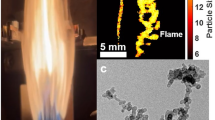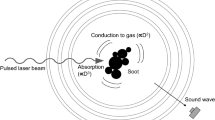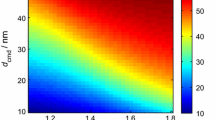Abstract
In many time-resolved laser-induced incandescence (TiRe-LII) experiments, it is common practice to relate the intensity emitted by laser-heated nanoparticles to the detected LII signal through a factor (here called the intensity scaling factor, ISF) that includes the particle volume fraction and other parameters that may not be the focus of the analysis. While, in the absence of evaporation or sublimation, the ISF should theoretically remain constant with respect to time, recent multi-wavelength measurements show that, in reality, it may vary with both time and fluence. We consider four candidate effects that contribute to this behavior: particle annealing; polydispersity in the nanoparticle-size distribution; background luminosity due to emission from nanoparticles in the line-of-sight before and behind the probe volume; and the temporal resolution of the detector. We demonstrate these effects by simulating TiRe-LII data for in-flame soot at atmospheric pressure, using new simplified heat transfer and annealing models. Analysis of experimental signals collected from flame-generated soot at atmospheric pressure reveals trends in the ISF similar to those predicted by simulations. These temporal variations provide important insights that can help to diagnose problems in TiRe-LII experiments and improve TiRe-LII models.















Similar content being viewed by others
References
H.A. Michelsen, C. Schulz, G.J. Smallwood, S. Will, Prog. Energy Combust. Sci. 51, 2–48 (2015)
P. Roth, A.V. Filippov, J. Aerosol Sci. 27, 95–104 (1996)
T. Lehre, B. Jungfleisch, R. Suntz, H. Bockhorn, Appl. Opt. 42, 2021–2029 (2003)
F. Liu, K.J. Daun, D.R. Snelling, G.J. Smallwood, Appl. Phys. B 83, 355–382 (2006)
T.A. Sipkens, R. Mansmann, K.J. Daun, N. Petermann, J.T. Titantah, M. Karttunen, H. Wiggers, T. Dreier, C. Schulz, Appl. Phys. B 116, 623–636 (2014)
S. Will, S. Schraml, A. Leipertz, Opt. Lett. 20, 2342–2344 (1995)
S. Schraml, S. Dankers, K. Bader, S. Will, A. Leipertz, Combust. Flame 120, 439–450 (2000)
J. Menser, K. Daun, T. Dreier, C. Schulz, Appl. Phys. B 122, 277–291 (2016)
T.A. Sipkens, P.J. Hadwin, S.J. Grauer, K.J. Daun, J. Appl. Phys. 123, 095103 (2018)
T. Sipkens, G. Joshi, K.J. Daun, Y. Murakami, J. Heat Transf. 135, 052401 (2013)
B. Mewes, J.M. Seitzman, Appl. Opt. 36, 709–717 (1997)
D.R. Snelling, G.J. Smallwood, F. Liu, Ö.L. Gülder, W.D. Bachalo, Appl. Opt. 44, 6773–6785 (2005)
P.J. Hadwin, T.A. Sipkens, K.A. Thomson, F. Liu, K.J. Daun, J. Opt. Soc. Am. A 35, 386–396 (2018)
R. Mansmann, T.A. Sipkens, J. Menser, K.J. Daun, T. Dreier, C. Schulz, Appl. Phys. B 125, 126–146 (2019)
C.F. Bohren, D.R. Huffman, Absorption and Scattering of Light by Small Particles (Wiley, New York, 1983)
C.M. Sorensen, Aerosol Sci. Technol. 35, 648–687 (2001)
F. Liu, K.A. Thomson, G.J. Smallwood, Appl. Phys. B 96, 671–682 (2009)
M.Y. Choi, K.A. Jensen, Combust. Flame 112, 485–491 (1998)
D.J. Bryce, N. Ladommatos, H. Zhao, Appl. Opt. 39, 5012–5022 (2000)
T.A. Sipkens, P.J. Hadwin, S.J. Grauer, P.J. Hadwin, Appl. Opt. 56, 8436–8445 (2017)
P.J. Hadwin, T.A. Sipkens, K.A. Thomson, F. Liu, K.J. Daun, Appl. Phys. B 122, 1–16 (2016)
T.A. Sipkens, N.R. Singh, K.J. Daun, Appl. Phys. B 123, 14–30 (2017)
T.A. Sipkens, Advances in the Modeling of Time-Resolved Laser-Induced Incandescence (PhD dissertation, University of Waterloo, 2018)
H.A. Michelsen, F. Liu, B.F. Kock, H. Bladh, A. Boiarciuc, M. Charwath, T. Dreier, R. Hadef, M. Hofmann, J. Reimann, S. Will, P.-E. Bengtsson, H. Bockhorn, F. Foucher, K.-P. Geigle, C. Mounaim-Rousselle, C. Schulz, R. Stirn et al., Appl. Phys. B 87, 503–521 (2007)
H.R. Leider, O.H. Krikorian, D.A. Young, Carbon 11, 555–563 (1973)
D.R. Snelling, K.A. Thomson, F. Liu, G.J. Smallwood, Appl. Phys. B 96, 657–669 (2009)
Ö.L. Gülder, D.R. Snelling, R.A. Sawchuk, Proc. Combust. Inst. 26, 2351–2358 (1996)
E. Nordström, N.E. Olofsson, J. Simonsson, J. Johnsson, H. Bladh, P.E. Bengtsson, Proc. Combust. Inst. 35, 3707–3713 (2015)
T.A. Sipkens, K.J. Daun, Opt. Express 25, 5684–5696 (2017)
T.A. Sipkens, K.J. Daun: MATLAB tools for TiRe-LII fluence curves, figshare. (2017). https://doi.org/10.6084/m9.figshare.5513497.v1
J. Zerbs, K.P. Geigle, O. Lammel, J. Hader, R. Stirn, R. Hadef, W. Meier, Appl. Phys. B 96, 683–694 (2009)
S. Kruse, P.R. Medwell, J. Beeckmann, H. Pitsch, Appl. Phys. B 124, 212–222 (2018)
F. Liu, K.J. Daun, V. Beyer, G.J. Smallwood, D.A. Greenhalgh, Appl. Phys. B 87, 179–191 (2007)
R.L. Vander Wal, M.Y. Choi, Carbon 37, 231–239 (1999)
R.L. Vander Wal, K.A. Jensen, Appl. Opt. 37, 1607–1616 (1998)
B. Apicella, P. Pré, J.N. Rouzaud, J. Abrahamson, R.L. Wal, A. Ciajolo, A. Tregrossi, C. Russo, Combust. Flame 204, 13–22 (2019)
F. Migliorini, S. De Iuliis, S. Maffi, G. Zizak, Appl. Phys. B 120, 417–427 (2015)
H.A. Michelsen, J. Chem. Phys. 118, 7012–7045 (2003)
E. Cenker, W.L. Roberts, Appl. Phys. B 123, 74–83 (2017)
Tami C. Bond, Robert W. Bergstrom, Aerosol Sci. Technol. 40, 27–67 (2006)
M. Saffaripour, K.P. Geigle, D.R. Snelling, G.J. Smallwood, K.A. Thomson, Appl. Phys. B 119, 621–642 (2015)
YuV Butenko, V.L. Kuznetsov, A.L. Chuvilin, V.N. Kolomiichuk, S.V. Stankus, R.A. Khairulin, B. Segall, J. Appl. Phys. 88, 4380–4388 (2000)
J.A. Newell, D.D. Edie, E.L. Fuller, J. Appl. Polym. Sci. 60, 825–832 (1996)
F. Liu, B.J. Stagg, D.R. Snelling, G.J. Smallwood, Int. J. Heat Mass Trans. 49, 777–788 (2006)
K.J. Daun, B.J. Stagg, F. Liu, G.J. Smallwood, D.R. Snelling, Appl. Phys. B 87, 363–372 (2007)
E. Cenker, G. Bruneaux, T. Dreier, C. Schulz, Appl. Phys. B 118, 169–183 (2015)
F. Liu, M. Yang, F.A. Hill, D.R. Snelling, G.J. Smallwood, Appl. Phys. B 83, 383–395 (2006)
H. Bladh, J. Johnsson, P.E. Bengtsson, Appl. Phys. B 90, 109–125 (2008)
G. J. Smallwood: A Critique of Laser-Induced Incandescence for the Measurement of Soot (PhD dissertation, Cranfield University, 2008)
S. Talebi Moghaddam, K.J. Daun, Appl. Phys. B 124, 159–172 (2018)
R. Mansmann, T. Drier, C. Schulz, Appl. Opt. 56, 7849–7860 (2017)
C. Schulz, B.F. Kock, M. Hofmann, H. Michelsen, S. Will, B. Bougie, R. Suntz, G. Smallwood, Appl. Phys. B 83, 333–354 (2006)
P.J. Hadwin, T.A. Sipkens, K.A. Thomson, F. Liu, K.J. Daun, Appl. Phys. B 123, 114–128 (2017)
S.K. Friedlander, C.S. Wang, J. Colloid Interface Sci. 22, 126–132 (1966)
F.L. Román, J.A. White, S. Velasco, A. Mulero, J. Chem. Phys. 123, 124512 (2005)
C.J. Shih, M.S. Strano, D. Blankschtein, Nat. Mater. 12, 866–869 (2013)
Z.W. Sun, D.H. Gu, G.J. Nathan, Z.T. Alwahabi, B.B. Dally, Proc. Combust. Inst. 35, 3673–3680 (2015)
K.M. Watson, Ind. Eng. Chem. 35, 398–406 (1943)
W.A. de Heer, D. Ugarte, Chem. Phys. Lett. 207, 480–486 (1993)
Acknowledgements
This work was supported by the Natural Sciences and Engineering Research Council of Canada (NSERC) (CGS 355451, DG 356267) and the German Research Foundation (DFG) (SCHU1369/14 and /26). We would also like to thank Dr. Thomas Dreier for his encouragement and advice and Sina Talebi Moghaddam for useful discussions on related topics.
Author information
Authors and Affiliations
Corresponding author
Additional information
Publisher's Note
Springer Nature remains neutral with regard to jurisdictional claims in published maps and institutional affiliations.
This article is part of the topical collection “Laser-Induced Incandescence”, guest edited by Klaus Peter Geigle and Stefan Will.
Electronic supplementary material
Below is the link to the electronic supplementary material.
Appendices
Appendix A: heat transfer model
The properties for the heat transfer model in this work were chosen close to the median of the range of values given in the literature previously, most notably from Ref. [24]. This model is chosen to increase the information entropy contained in the model by preventing overtuning to specific laboratory settings, particularly given the disparity of soot properties given in the literature (cf. the range of trajectories for the nanoparticle temperature shown in Ref. [24]. While this model lends itself particularly well to statistical analyses (consideration of which are the topic of future work), point estimates produced by such a model are also beneficial from an information entropy perspective. The values used in this work are summarized in Table 3.
Several notes are also made here on the function forms chosen for ΔHv, pv, and mv. Above the melting point, we use the universal expression recently proposed by Román et al. [55]:
where ΔHv,ref and Tref are a reference latent heat of vaporization and temperature, n is the critical exponent, βR = 0.37 [55], and Tcr is the critical temperature. Below the melting temperature, we use a linear expression that closely fits the data in Leider et al. [25]. Based on the correlations provided by Leider et al. [25], we separate the changes in mv with temperature into three regimes: (i) low temperatures, where C1 is the dominant evaporated species, though not in significant quantities; (ii) beyond 1900 K where C3 becomes dominant; and (iii) finally, beyond 4500 K where the vapor becomes a mixture composed significantly of C3, C5, and C7. Accordingly, we model the molecular mass of the vapor using a sigmoid function, so that the transitions between the different regimes are smooth. Finally, the vapor pressure is evaluated using the Kelvin equation, which accounts for the enhanced surface energy due to curvature:
where γs = 0.18 J/cm2 is the surface tension [56] and pv,o is the nominal vapor pressure above a bulk surface, given by the Clausius–Clapeyron equation:
where pv,ref, Tref, and ΔHv,ref are reference values, in this case, different from those in Eq. (34). These quantities are generally consistent with the parameters of other TiRe-LII evaporation models presented by Michelsen et al. [24] and the original work of Leider et al. [25], although they predict slightly greater evaporation, and, consequently, steeper temperature decays, close to the laser pulse.
Appendix B: annealing model
The annealing model is based on the reducing sphere model of Butenko et al. [42] and assumes that graphitization initiates instantaneously over the primary particle surface. While this may not quantitatively represent the physics, it represents a simple model that accounts for the increased energy of the atoms at the surface, which makes it easier for the atoms to restructure. The transformation then progresses into the interior of the primary particle with a single rate, k. The transformed fraction of the individual primary particle X at any given time is described by the following [42]:
where dp,t is the diameter of the untransformed material at any time. It can then be shown that the rate of change in X is given by the following:
The progression of the transformed phase is governed by the Arrhenius equation:
where EA is an activation energy and A0 is a pre-exponential factor. The activation energy is taken as EA = 400 kJ/mol, chosen on the lower end of the values reported in the literature (generally in the range of 400–1000 kJ/mol [43]), and the exponential prefactor is set to A0 = 1.0 × 105 s−1. These quantities bring the model into agreement with Michelsen’s model at high temperatures, where it is considered reliable, while predicting slower annealing (on the order of milliseconds to hours) at flame temperatures and low fluences, consistent with Refs. [39, 59]. The final form of the rate of change in X is, thus:
This form has the consequence that the rate of dX/dt is faster for smaller nanoparticles where there is less material to be transformed. The proposed model also allows for freezing of the transformation at values of X < 1 for moderate heating. We use X = 0 as an initial condition, as the annealing rate at flame conditions is assumed to be slow, and solve Eq. (40) using a fourth-order Runge–Kutta scheme.
Rights and permissions
About this article
Cite this article
Sipkens, T.A., Menser, J., Mansmann, R. et al. Investigating temporal variation in the apparent volume fraction measured by time-resolved laser-induced incandescence. Appl. Phys. B 125, 140 (2019). https://doi.org/10.1007/s00340-019-7251-7
Received:
Accepted:
Published:
DOI: https://doi.org/10.1007/s00340-019-7251-7




